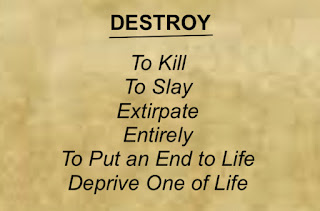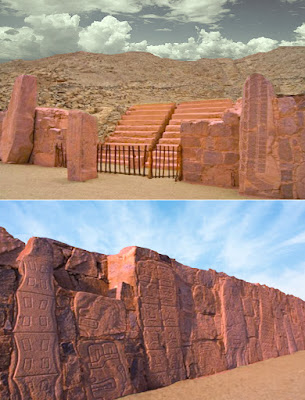Continued from the previous post regarding the claims of theorists and scholars that many Nephites survived the final battle between the Nephites and Lamanites
In addition to what was covered in the last post, Mormon tells us that the Lamanites swept through these towns and villages that Mormon and his army quit, killing everyone that did not flee with Mormon and his army. He put it this way: “The Nephites did again flee from before them, taking all the inhabitants with them, both in towns and villages” (Mormon4:22); and “We did again take to flight, and those whose flight was swifter than the Lamanites' did escape, and those whose flight did not exceed the Lamanites' were swept down and destroyed” (Mormon 5:7); and also “Whatsoever lands we had passed by, and the inhabitants thereof were not gathered in, were destroyed by the Lamanites, and their towns, and villages, and cities were burned with fire; and thus three hundred and seventy and nine years passed away” (Mormon 5:5).
Those left in towns or villages were rounded up by the warring Lamanites and killed if they would not deny the Christ
Mormon obviously did not think that any Nphites that would not join him and his armies would have survived. In addition, such information would have been communicated to the inhabitants of each city, town and village they passed—and knowing the 1,000-year history of the Lamanites’ lust for their blood, it would be unlikely that these people would need to be convinced to flee. The fact that some Nephites were slower in their flight only shows that the Nephites understood their danger, but could not travel faster than the approaching Lamanites, who took delight in killing those they caught.
Obviously, the murderous, unrestrained brutality of the Lamanites’ thirst for the blood of the Nephites was so vicious and all-consuming that they killed every Nephite they could find, even tracking down a few who had escaped into the south countries and killing them. Even after every Nephite had been destroyed, Moroni still feared for his life, telling us that “the Lamanites are at war one with another; and the whole face of this land is one continual round of murder and bloodshed; and no one knoweth the end of the war” (Mormon 8:8). 36 years later, Moroni tells us these civil wars were still going on: “For behold, their wars are exceedingly fierce among themselves” (Moroni 1:2).
At the conclusion of these 63 years of wars, Mormon tells us that “when three hundred and eighty and four years had passed away, we had gathered in all the remainder of our people unto the land of Cumorah” (Mormon 6:5—emphasis added). And Moroni makes it quite clear that every Nephite was dead when he wrote: “the Lamanites have hunted my people, the Nephites, down from city to city and from place to place, even until they are no more” (Mormon 8:7—emphasis added).
It is amazing that theorists can, in light of this very clear language, claim a contrary situation where “large numbers of Nephites” were not killed simply because they did not agree to join in the fight. It would be an interesting conversation between Moroni, who saw that they were all killed, and present-day theorists who insist they were not.
Nor are scholars free from this thinking as seen in Daniel H. Ludlow, in quoting Hugh Nibley, who said: “The Nephites were destroyed, we are told, but . . . what does the Book of Mormon mean by destroyed? The word is to be taken, as are so many other key words in the book, in its primary and original sense: To unbuild; to separate violently into its constituent parts; to break up the structure.' To destroy is to wreck the structure, not to annihilate the parts.”
On the contrary, destroy is defined in the 1828 American Dictionary of the English Language, “To kill; to slay; to extirpate; applied to men or other animals. To kill or slay means to “put an end to life” and “deprive one of life.” Extirpate means to remove completely, make extinct; eradicate, exterminate, annihilate, destroy. In general, to put an end to. Biblical use of “destroy” is found in “Ye shall destroy all this people” (Numbers 32:15); “All the wicked will he destroy” (Psalms 145:20). In the Book of Mormon we find: ”The Jews might not know concerning our flight into the wilderness, lest they should pursue us and destroy us” (1 Nephi 4:36); “Lamanites should come upon us and destroy us; for I knew their hatred towards me and my children and those who were called my people” (2 Nephi 5:14).
On the other hand, there are several comments of not being destroyed: “May the Lord bless thee forever, for thy seed shall not utterly be destroyed” (2 Nephi 3:3) “Because of this covenant thou art blessed; for thy seed shall not be destroyed, (2 Nephi 3:23); and “Wherefore, thou shalt not utterly be destroyed; but in the end thy seed shall be blessed” (2 Nephi 4:9).
In fact, Hugh Nibley pointed out that “the Lord promised He would not utterly destroy the descendants of Lehi's youngest son, Joseph. (2 Nephi 3:3.) Also Nephi was told God "will not suffer that the Gentiles will utterly destroy the mixture of thy seed which are among thy brethren" (1 Nephi 13:30) even though the promises and fulfillment were that the Nephites should be "destroyed" (Ether 8:21) and even though Moroni could write, there is none, save it be Lamanites” (Ether 4:3).
This is not a complicated matter—there are three sources for this to be fulfilled:
• 1) Those who went north in Hagoth’s ships, some of whom were never heard from again (Alma 63:6-8);
• 2) Those who defected over to the Lamanites—“Now the Zoramites were dissenters from the Nephites” (Alma 31:8); “All those who had dissented from the Nephites, who were Amalekites and Zoramites, and the descendants of the priests of Noah” (Alma 43:13), and “Whosoever did mingle his seed with that of the Lamanites did bring the same curse upon his seed” (Alma 3:9), and
• 3) Those who went by ship to an unknown destination (Alma 63:8)—When the cornerstone was laid at the New Zealand Temple, Elder Hugh B. Brown stated in the closing prayer: “We thank Thee, O God, for revealing to us the Book of Mormon, the story of the ancient inhabitants of America. We thank Thee that from among those inhabitants, the ancestors of these whose heads are bowed before Thee here, came from the western shores of America into the South Seas pursuant to Thy plan and now their descendants humbly raise their voices in grateful acknowledgement of Thy kindness, Thy mercy, and Thy love for them and those who went before them. We humbly thank Thee that this building is erected in this land, so that those faithful Maoris who came here in early days, descendants of Father Lehi, may be remembered by their descendants and saved through the ordinances that will, in this House, be performed in their behalf” (emphasis added) (David W. Cummings, Mighty Missionary of the Pacific, Bookcraft, Salt Lake City, 1961, p63; Paul R. and Millie Foster Cheesman, Early America and the Polynesians, Promised Lands Publication, Provo, Utah, 1975, p14).
We need to keep in mind how the scriptural record came about to further understand this. The prophets who wrote on the plates, most of which Mormon abridged, were both written and abridged under the Spirit as seen in Mormon’s comment: “And now I, Mormon, proceed to finish out my record, which I take from the plates of Nephi; and I make it according to the knowledge and the understanding which God has given me” (WofMormon 1:9, emphasis added). The words of the Spirit constrained the prophets in their writing and actions as Nephi and others pointed out: “Behold, my brethren, I have spoken unto you, according as the Spirit hath constrained me; wherefore, I know that they must surely come to pass” (2Nephi 28:1, emphasis added); also Jacob: “Wherefore, it burdeneth my soul that I should be constrained, because of the strict commandment which I have received from God” (Jacob 2:9, emphasis added). Others indicate the same thing: “Therefore he was constrained to speak more unto them” (Helaman 8:11, emphasis added); “Also the Disciple Nephi: “Therefore he was constrained to speak more unto them” (4 Nephi 1:48, emphasis added).
Consequently, the prophets who wrote and abridged the plates were guided by the Spirit, Joseph Smith, who translated the record, was guided by the Spirit, and the Lord said of that work that it was the most perfect book written on that subject (not grammar, tense, or spelling—but subject). It is amazing that scholars, theorists and members feel they have to tell us that the book needs special understanding to know what was meant. That is the scriptural record, which was written by the Spirit, abridged by the Spirit and translated by the Spirit, is both misleading, and in some cases hidden from our understanding.























